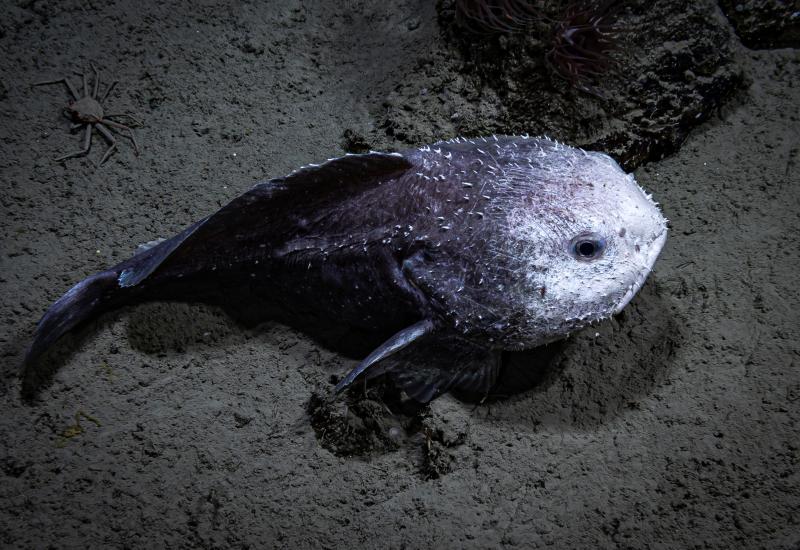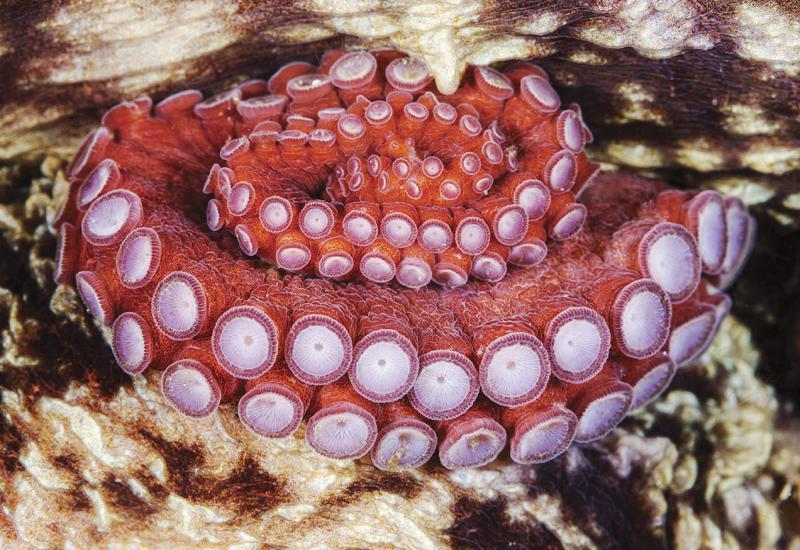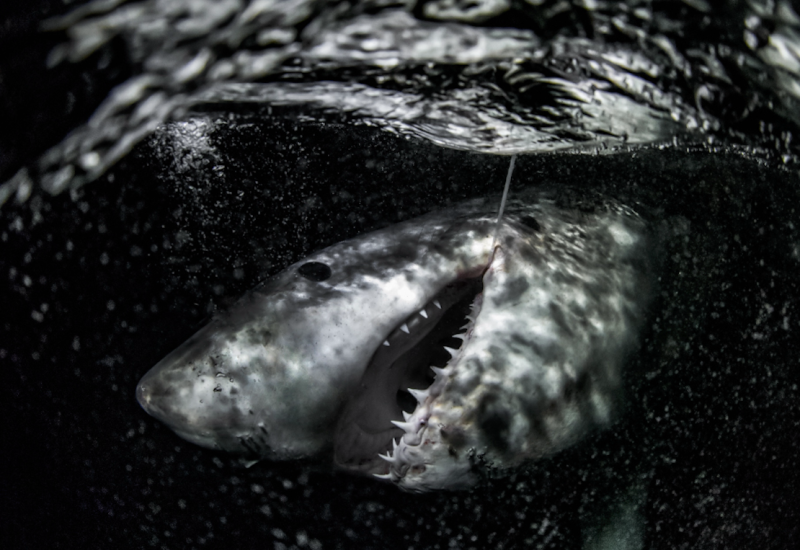Disappearing Arctic Sea Ice Puts Vital Marine Habitat on Thin Ice
We’ve left the refrigerator door wide open in our planetary kitchen — the food-generating, climate-regulating heart of Earth. How we respond in the next few years will determine our fate.
The reflective frozen skin of sea ice covering the Arctic Ocean is now set at defrost, increasingly exposing the dark open ocean beneath. With the sea absorbing the sun’s energy — instead of ice reflecting it back into space — the Arctic region is warming twice as fast as the rest of the planet. As Nathan Kurtz of NASA’s Goddard’s Space Flight Center in Maryland puts it: “When we lose the reflecting cover of the Arctic Ocean, we lose a mechanism to cool the planet.”
When you board a dive boat in the tropics, a changing Arctic landscape might seem of little consequence, but according to Tim Gallaudet, acting administrator of NOAA, “What happens in the Arctic doesn’t stay in the Arctic; it affects the rest of the planet.” Food-web disruptions, loss of permafrost, resource speculation and sovereignty disputes indelibly alter the complexion of an otherwise pristine sanctuary. The next time your local dive boat is canceled due to sea conditions, think of this: Research proves that changes in Arctic sea ice and temperatures alter the jet stream, which drives worldwide weather patterns. What happens in the Arctic will come back to haunt us.
The Land
My Inuit guide, Kevin Enook, revs his snowmobile and pulls taut the thick rope that leads back to the traditional wooden qamutik sled, piled high with my technical dive gear and cameras. The irony of hauling advanced, state-of-the-art digital equipment using technology developed thousands of years ago is not lost on me.
Enook’s wisdom defies his age; he is the product of a life outdoors, spent learning from his elders. His Oakley sunglasses cover a white, raccoonlike mask across his mahogany skin. Under the glasses, his dark eyes spot subtle changes on the horizon. We lurch forward, spraying a rooster tail of slush the way a boat creates a wake. Enook weaves skillfully across the melting white landscape. His life and that of his people rely on understanding the ice. Fall through it, and you die.
Enook finds it hard to believe that my dive buddy Nathalie Lasselin and I want to dive deep beneath the frozen surface, more than 430 miles north of the Arctic Circle.
Arctic on the Edge
Both maximum (top) and minimum sea-ice levels are in decline. According to the National Snow and Ice Data Center, the March 2017 maximum is the lowest in the 38-year satellite record. In September, the minimum was the eighth lowest. The orange lines show the 1981 to 2010 average extent for the same months. The 1981 to 2010 average provides a consistent baseline for year-to-year comparisons of sea-ice extent. The NSIDC provides monthly updates at nsidc.org.
We are chasing the fleeting remains of icebergs that calved from Greenland’s ice sheet approximately one year ago. After crossing the Davis Strait, these colossal summits of ice get frozen into pack ice for the winter before being set free to drift down the coasts of Baffin Island, Labrador and Newfoundland. In the past, a few rogue chunks have made it as far as Bermuda, but most dissolve into the sea before leaving Canadian waters.
We surf across a frighteningly wide break in the ice and resume our race toward a silvery pinnacle on the horizon. I am in awe of the majesty of the snow-covered peaks. Their glaciers descend to touch the sea ice that the Inuit call “the Land.” I feel the connection of people, snow and mountains; the Arctic is like one harmonious organism.

Jill HeinerthLion’s mane jellyfish (Cyanea capillata) are a cold-water species that cannot tolerate warm waters. The tentacles of the longest-known one measured 120 feet — longer than a blue whale.
Arriving at our destination, we note a small strip of open water on the edge of the iceberg offering just enough space for us to slip beneath the surface. A seal pops up to breathe and then quickly disappears again. Under the bright sun and a cobalt-blue sky, fresh water spills down the sheer face of the iceberg in streaming rivulets that furrow the surface in vertical channels.
Enook threads a titanium ice screw into the hard surface a few feet back from the midnight-blue hole. He prepares a line that will connect us and knocks away the unstable edges where he will stand.
“I’ll dry your boots while you are gone,” he says as he removes the damp insoles from my heavy winter boots. His thoughtful gesture to lay the insoles in the warm sun reflects his character as much as his commitment to safety. He knows how important it is to keep everyone on the team warm and dry.
Settling into the water, a band of slurry first obscures my vision. I drop through a slushy halocline of mixing salt and fresh water and get my first look. Long runners of algae waft in the current, held fast to the undersurface of ice. It’s a good sign, since alga and other nutrients locked within the ice will feed the zooplankton that stabilizes the bottom of the Arctic food web. Bottom dwellers such as anemones, sponges and halibut will, in turn, feed other fish and marine mammals like belugas, narwhal or bowhead whales. But I also notice that Enook stands on perilously thin ice. And as the remaining ice disappears, so will his people, and the entire Arctic.

Jill HeinerthThe author pauses for a selfie (left); Inuit guide Kevin Enook.
“I remember when the ice was 8 to 10 feet thick,” he tells me. “But now it is thin and doesn’t stay very long.”
The subsurface of the iceberg is dimpled and fluted, carved by the undersea currents that now pull my rope taut. I’m connected to Enook like a fish on a line. Falling down the frozen facade, I observe layers of time that could date this ice back 10,000 or more years. Some seams are hauntingly transparent, while others are packed tight with small white air bubbles that now fizz as they dissolve. Deeper, I reach a colorful carpet of orange kelp that hides a miniature garden of crustaceans and Cnidaria. I look upward to see Nathalie descend on a silvery thread of bubbles. She kicks hard to pull her line toward me in the strong current. We both realize that we are privileged to experience this fragile kingdom. By morning, this ice-floe edge will break away, and our dive site will drift out to sea. We are the first and last to document this place.
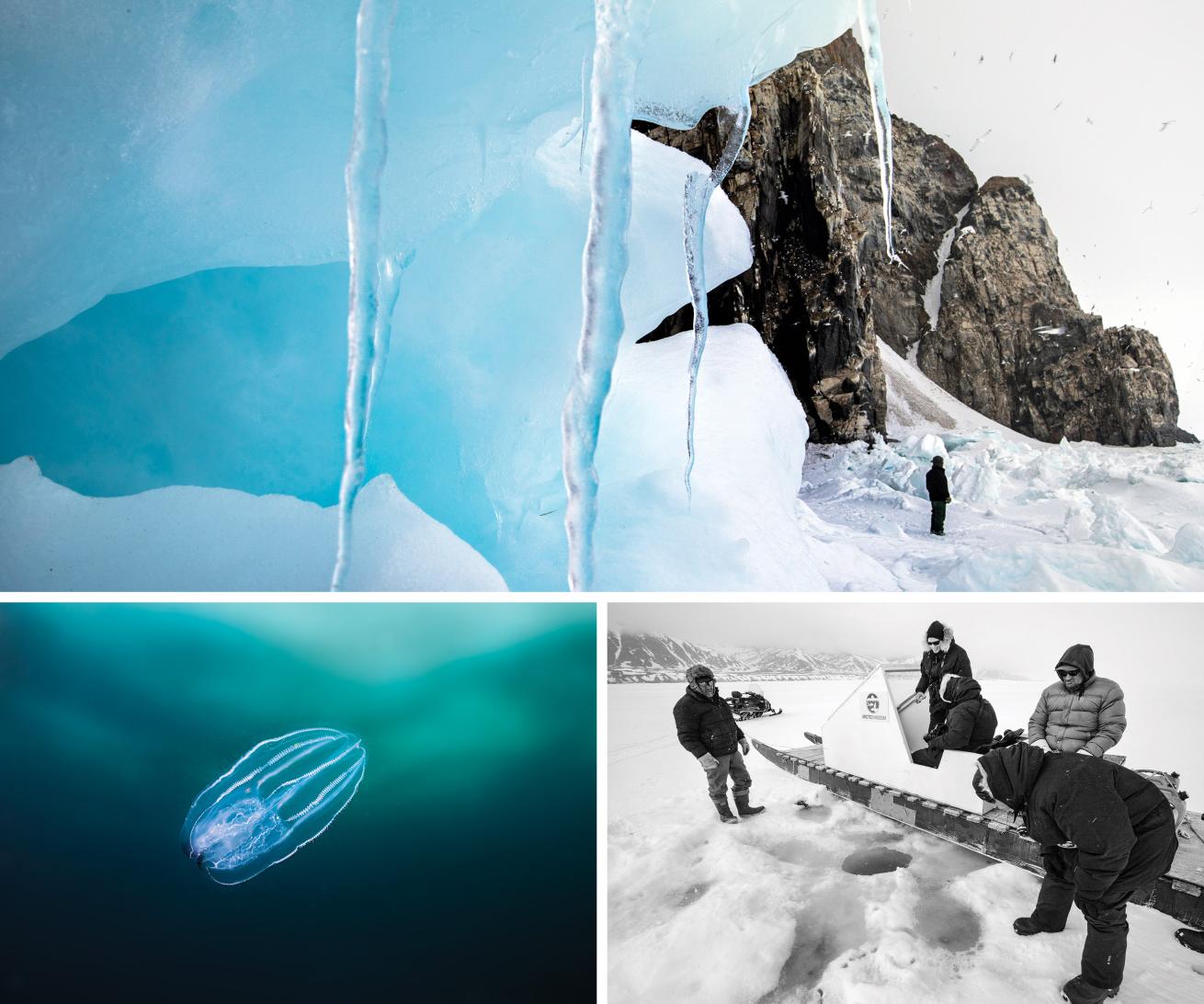
Jill HeinerthClockwise from top: The edge of the ice floe at Bylot Island Migratory Bird Sanctuary on the final afternoon, just before the ice broke up for the season. Seventy-four species of Arctic birds thrive here, including the largest colony of breeding Canadian snow geese in the High Arctic; a seal’s breathing hole; a beroe comb jelly with its iridescent cilia — this species was first described in scientific literature in 1780.
When NOAA presented its annual Arctic Report Card in 2017, the findings were dire. Arctic seawater is getting warmer, and sea ice is melting at the fastest pace observed in at least 1,500 years. Using shells, sediments, ice cores, tree rings and fossils as climate evidence, NOAA reports that the Arctic is transforming at a rate “far beyond what’s occurred in the region for millennia.”
Food for Thought
Producers, predators, scavengers and parasites are all part of the Arctic food web. A polar bear depends on sea ice to travel to hunt its favorite meal of ringed seal. The seals eat Arctic cod, which feed on algae and other tiny organisms. Scientists don’t know enough about the ecosystem to predict the future for these animals, but they say climate change might be happening too rapidly for adaptation.
In March 2017, maximum levels of winter sea ice were the smallest ever recorded, and nearly 80 percent of that ice was thin and only a year old. Just 30 years ago, almost half of the Arctic sea-ice cover was made up of thick, multiyear ice. The report adds that these substantial changes coincide with measurable increases in carbon-dioxide levels in our atmosphere.
This year’s minimum sea-ice coverage, measured each September, was in bad shape too. Sea-surface temperatures in August 2017 were more than 7 degrees Fahrenheit higher than the average in the Barents and Chukchi seas. Plankton blooms were increasing, and fisheries in the Bering Sea were in trouble.
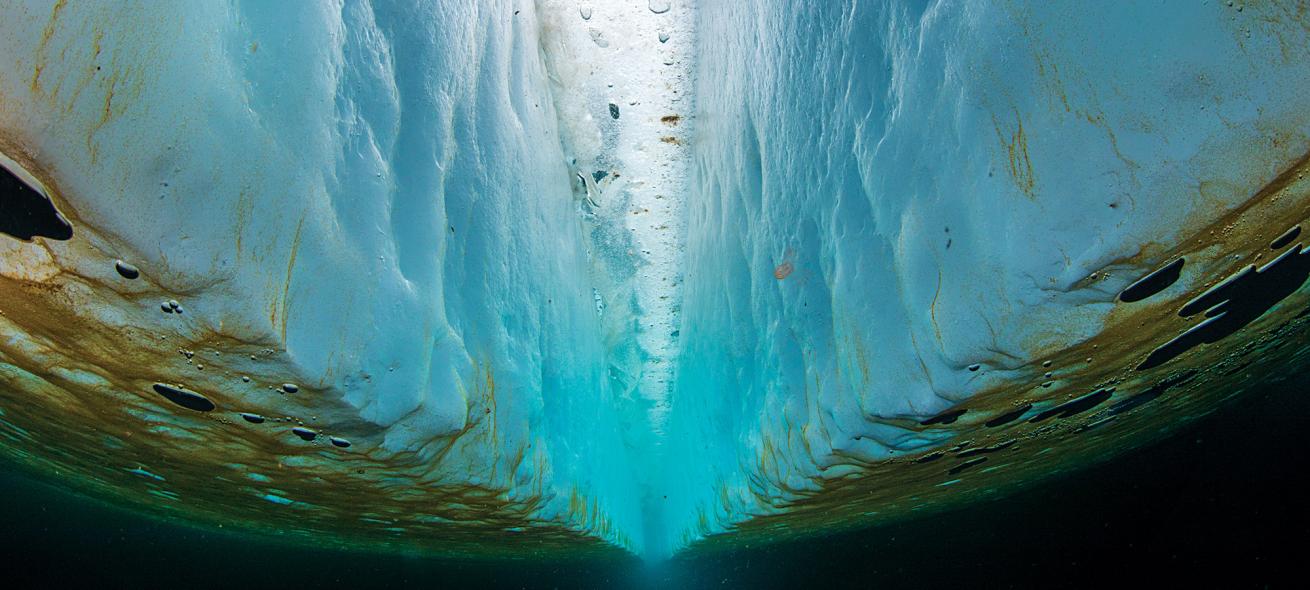
Jill HeinerthCommunities of sea-ice algae are found on all parts of sea ice, including its underside. Algae make their way into the ice from the ocean during the formation of slushy “frazil” ice — the first stage of sea ice — bringing with it all manner of microbial life.
Scientists assert that an ice-free Arctic Ocean will arrive within decades, and some say as early as 2020. What will happen to the people and animals of the land?
Enook knows that the hunting season on the Land will be shorter than last year’s. His eyes sweep the horizon, taking it all in. “We can’t change it,” he says. “We will adapt — we have no choice.”
Jill Heinerth was awarded the prestigious Polar Medal by Canada’s governor general in 2017. Read more about Heinerth’s “Arctic on the Edge” project sponsored by the Royal Canadian Geographical Society at intotheplanet.com/arctic.


